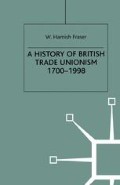Abstract
By the winter of 1920 there were clear signs of an economic depression setting in. Unemployment took a sharp leap in December and short-time working began to spread. By March 1921, unemployment had reached over 10 per cent by one measure — 15 per cent of insured workers. The miners’ lockout from April pushed the figure up to over 20 per cent of insured workers. Union membership which peaked at 8.3 million in 1920 fell by 1.7 million in a year. By 1926 three million members had been lost and not until 1935 was the downward slide to be halted. A union density of 45.2 per cent in 1920 had become 22.6 per cent in 1933. It was a period of disastrous decline and often misdirected effort and one in which workers lost out badly, both in terms of wages and in struggles over the ‘frontiers of control’ in the work-place.
Preview
Unable to display preview. Download preview PDF.
Author information
Authors and Affiliations
Copyright information
© 1999 W. Hamish Fraser
About this chapter
Cite this chapter
Fraser, W.H. (1999). The Industrial Relations of Depression, 1921–33. In: A History of British Trade Unionism 1700–1998. British Studies Series. Palgrave, London. https://doi.org/10.1007/978-1-349-27558-8_7
Download citation
DOI: https://doi.org/10.1007/978-1-349-27558-8_7
Publisher Name: Palgrave, London
Print ISBN: 978-0-333-59611-1
Online ISBN: 978-1-349-27558-8
eBook Packages: Palgrave Business & Management CollectionBusiness and Management (R0)

